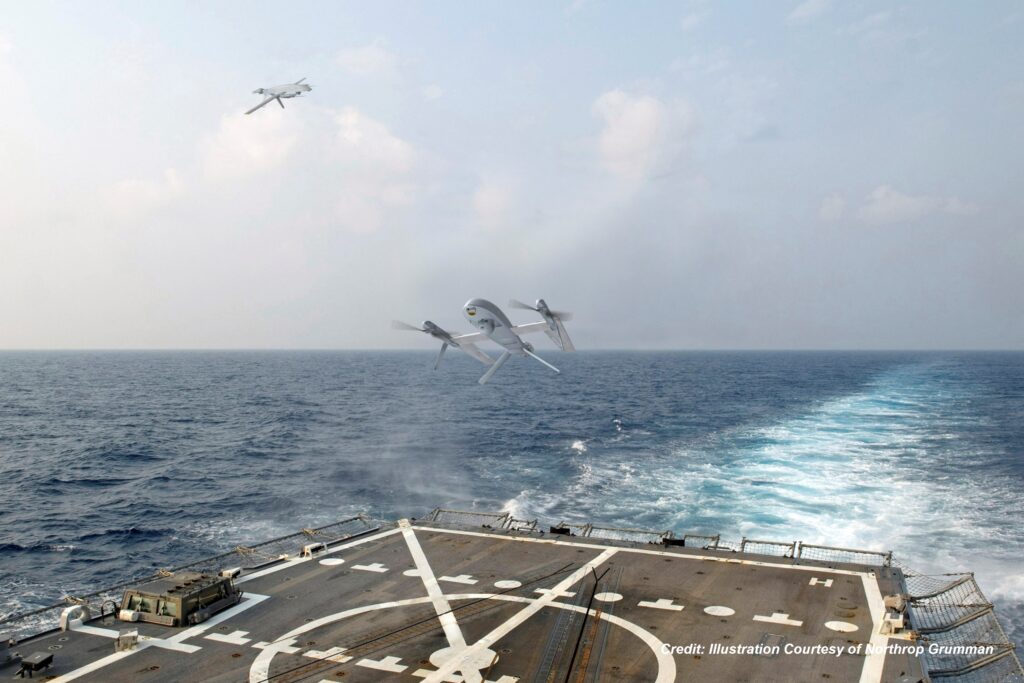Northrop Unveils DARPA Shipboard Drone Concept for Navy Tactical Missions


The Defense Advanced Research Project Agency’s (DARPA) Tactical Technology Office awarded a contract to Northrop Grumman for designing an autonomous VTOL aircraft system. (Photo: U.S. Navy)
Northrop Grumman has unveiled the design of the new autonomous uncrewed vertical take-off and landing aircraft capable of operating from Navy ships at sea that it will build under a new contract from the Defense Advanced Research Project Agency’s (DARPA) Tactical Technology Office.
The as-yet unbuilt aircraft has been given a typically terrible Defense Department acronym: ANCILLARY, which stands for AdvaNced airCraft Infrastructure-Less Launch And RecoverY. The Northrop-built demonstrator should be a cost-efficient, multiple-mission capable vehicle built on an agile platform that is runway independent.

Northrop is one of nine companies awarded contracts in late June to produce initial operational system and demonstration system conceptual designs for the DARPA program. AeroVironment, AVX Aircraft, Griffon Aerospace, Karem Aircraft, Leidos, Method Aeronautics, Northrop Grumman, Piasecki Aircraft, and Sikorsky will develop VTOL UAS designs, with Navy and Marine missions in mind, during the six-month Phase Ia. Teams then will submit competitive proposals for more detailed X-plane design work.
DARPA foresees a relatively small drone weighing somewhere between 250 and 300 pounds so that several can be deployed on a single ship. The MQ-8C Fire Scout, also developed by Northrop Grumman, is a full-sized Bell 407 helicopter outfitted to fly without a crew on board. Ideally, the system should require only two people to set up, launch, operate, and recover, DARPA has said.
The U.S. Navy conducted calibration flight testing of the Leonardo Osprey 30 AN/ZPY-8 radar for the MQ-8C Fire Scout drone in 2020. The helicopter system was deployed operationally at the end of 2021.
Northop’s ANCILLARY is designed to carry a 60-pound sensor payload with 20 hours of endurance and a mission radius range of 100 nautical miles. That should surpass current unmanned aircraft systems without using significant additional infrastructure aside from what is on board the air vehicle. The system will also have the capability to land on a ship in adverse weather conditions.
Conceptual drawings of Northrop’s design show a torpedo-shaped main fuselage with twin, fixed engine nacelles, each with a downward-facing propeller, mounted midway on wings that fold for vertical flight and extend into an airplane configuration for forward flight. The aircraft has a chin-mounted sensor ball and appears to have a pusher prop aft to propel it forward during level flight.
Northrop said that the aircraft will be capable of performing intelligence, surveillance, reconnaissance and targeting missions, and supporting expeditionary missions for special operations forces and logistical missions with significant affordability impacts for ship-to-shore transition of parts and supplies.
“In collaboration with DARPA, Northrop Grumman will work to significantly enhance how future autonomous vertical lift aircraft will operate at sea and ashore,” said Tim Frei, vice president of research and advanced design at Northrop Grumman. “The ANCILLARY program enables us to combine our digital engineering expertise with extensive knowledge and insights from past successes in developing and operating uncrewed vertical lift aircraft for the U.S. Navy.”
ANCILLARY aims to solve a combination of challenging design objectives by bringing together technology development in advanced VTOL aircraft configurations, advanced propulsion architectures, and advanced control effectors/theory from traditional and non-traditional industry companies, according to DARPA.
“The objectives of the program are to develop a small UAS that takes off and lands vertically, like a helicopter, and flies its mission like very efficient winged aircraft, while carrying a significant amount of payload for a variety of missions,” Steve Komadina, DARPA’s ANCILLARY program manager, said in June when the contracts were awarded. “We are looking for a VTOL UAS that can operate from ship flight decks and small out-of-the-way land locations in most weather conditions without using typical launch and recovery equipment that is needed for current long endurance, high payload weight aircraft.”
“The major challenge is developing an integrated flight vehicle that meets the hard objective of combining VTOL, long endurance, and large payload while also meeting requirements for shipboard storage and operations,” Komadina added. “A key element is the propulsion system, which needs to have enough power to lift the X-plane vertically while also being extremely efficient in forward flight when power needs are lower.”
The project is expected to culminate with X-plane flight tests in early 2026.
—————
Boost Internet Speed–
Free Business Hosting–
Free Email Account–
Dropcatch–
Free Secure Email–
Secure Email–
Cheap VOIP Calls–
Free Hosting–
Boost Inflight Wifi–
Premium Domains–
Free Domains





